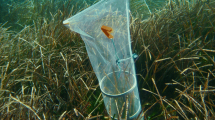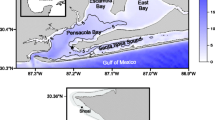Abstract
We developed incubation chambers of clear acrylic extending the full depth of the water column to measure in situ depth-integrated community metabolism in experimental planktonic–benthic ecosystems. A magnetic stirring apparatus at mid-depth in each chamber prevented stratification and maintained a vertical turnover time that roughly matched turnover in the experimental ecosystems. We used the chambers in light–dark experiments to partition the depth-integrated photosynthesis and respiration occurring in the experimental ecosystems among water column, wall periphyton, and benthic communities. Community metabolism measured with the chambers was positively related to the chlorophyll-a concentrations of the water column and wall periphyton communities. We also found close agreement between the summation of partitioned community metabolism measured in the chambers and an independent measure of total ecosystem metabolism in the experimental ecosystems. Incubations in chambers and in light–dark bottles revealed similar patterns of water column and wall periphyton community metabolism, but magnitudes differed. In addition to application in experimental ecosystems, this incubation chamber technique may provide an efficient and realistic measure of water column and benthic metabolism and nutrient uptake in lakes and estuaries.
Similar content being viewed by others
References
Carritt, D. E. & J. H. Carpenter, 1966. Comparison and evaluation of currently employed modifications of the Winkler method for determining dissolved oxygen in seawater; a NASCO report. J. Mar. Res. 24: 286-318.
Chen, C.-C., J. E. Petersen & W. M. Kemp, 1997. Spatial and temporal scaling of periphyton growth on walls of estuarine mesocosms. Mar. Ecol. Prog. Ser. 155: 1-15.
Confer, J. L., 1972. Interrelations among plankton, attached algae and phosphorous cycle in artificial open systems. Ecol. Monogr. 19: 1-23.
Doty, M. S. & M. Oguri, 1958. Selected features of the isotopic carbon primary productivity technique. Rapport et Proces-Verbaux des Reunions. Conseil Permanent International pour l'Exploration de la Mer 144: 47-55.
Eppley, R. W., P. Koeller & G. T. J. Wallace, 1978. Stirring in-fluences the phytoplankton species composition within enclosed columns of coastal sea water. J. Exp. Mar. Biol. Ecol. 32: 219-239.
Falkowski, P. G., 1980. Light-shade adaptation in marine phytoplankton. In P. G. Falkowski (ed.), Primary Productivity in the Sea. Plenum, New York: 99-120.
Gaarder, T. & H. H. Grann, 1927. Investigations of the production of plankton in the Oslo Fjord. Rapport et Proces-Verbaux des Reunions. Conseil Permanent International pour l'Exploration de la Mer 42: 3-31.
Jewson, D. H. & R. B. Wood, 1975. Some effects on integral photosynthesis of artificial circulation of phytoplankton through light gradients. Verh. int. Ver. Limnol. 19: 1037-1044.
Madden, C. J. & J. W. Day, 1992. Induced turbulence in rotating bottles affects phytoplankton productivity measurements in turbid waters. J. Plankton Res. 14: 1171-1191.
Petersen, J.E., J. Cornwell & W. M. Kemp, 1999. Implicit scaling in the design of experimental ecosystems. Oikos 85: 3-18.
Petersen, J.E., L.P. Sanford, & W.M. Kemp, 1998. Coastal plankton responses to turbulent mixing in experimental ecosystems. Mar. Ecol. Prog. Ser. 171: 23-41.
Petersen, J. E., C.-C. Chen & W. M. Kemp, 1997. Spatial scaling of aquatic primary productivity: experiments under nutrient and light-limited conditions. Ecology 78: 2326-2338.
Rees, J. T., 1979. Community development in freshwater microcosms. Hydrobiologia 63: 113-128.
Smetacek, V., B. con Bodungen, B. Knoppers, H. Neubert, F. Pollehne & B. Zeitschel, 1980. Shipboard experiments on the effect of vertical mixing on natural plankton populations in the central Baltic Sea. Ophelia 1 (suppl.): 77-98.
Taylor, D., S. Nixon, S. Granger & B. Buckley, 1995. Nutrient limitation and the eutrophication of coastal lagoons. Mar. Ecol. Prog. Ser. 127: 235-244.
Thomas, E. A., 1958. Das Plankton-Test-Lot, ein Gerat zum Studium des Verhaltens von Planktonorganismen im See. Monatsbulletin des Schweizeriches Vereins von Gas-und Wasserfach mannern 1: 3-8.
Van Heukelem, L., A. J. Lewitus, T. M. Kana & N. E. Craft, 1994. Improved separations of phytoplankton pigments using temperature-controlled high performance liquid chromatography. Mar. Ecol. Prog. Ser. 86: 451-261.
Author information
Authors and Affiliations
Rights and permissions
About this article
Cite this article
Petersen, J.E., Chen, CC. A method for measuring depth-integrated community metabolism in experimental planktonic–benthic ecosystems. Hydrobiologia 391, 23–31 (1998). https://doi.org/10.1023/A:1003507815790
Issue Date:
DOI: https://doi.org/10.1023/A:1003507815790




